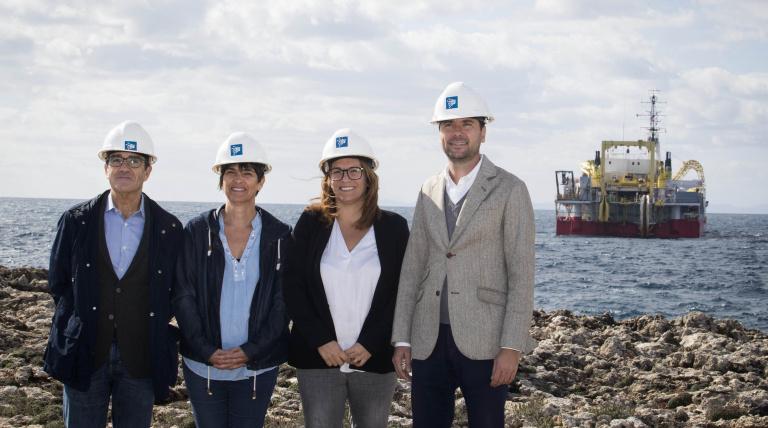We are a global operator of essential infrastructure
- Commissioning is scheduled for the third quarter of 2020.
- The interconnection is comprised of a three-core 132 kV submarine-underground cable that has a total weight of 2,300 tonnes.
- The route includes 41 km of cable laid on the seabed, at a maximum depth of 81 meters, and 12.4 km of cable installed underground in Menorca and 800 meters in Majorca.

Just a year after the Spanish Council of Ministers authorised the construction of a new electricity cable between Menorca and Mallorca, the cable laying ship ‘Skagerrak’ is already in Punta Sa Guarda (Ciudadela) to begin the preparations to carry out the subsea cable laying work for this interconnection. Once the reconnaissance tasks and preparatory work have been completed regarding the established subsea route to be used to lay the submarine cable, the next step will be carried out immediately once the weather conditions guarantee a sufficient time window that ensures the integrity and physical safety of the cable installation and of the teams that will carry out the cable laying work.
This new interconnection, which is scheduled to be commissioned in the third quarter of 2020, will connect Menorca with the entire Balearic Islands’ electricity system and with the Spanish peninsula. With a cost of 84 million euros, it will decisively improve the security and quality of supply in Menorca, facilitate progress in the energy transition of Menorca and the Balearic Islands, maximize the evacuation of renewable energy under safe conditions for the system and reduce CO2 emissions in Menorca.
The works underway were visited today by the Vice President of the Balearic Government and Regional Minister of Energy Transition and Productive Sectors, Juan Pedro Yllanes; the Chairwoman of the Island Council of Menorca, Susana Mora; the head of Industry and Energy of the Government’s regional delegation in the Balearic Islands, Santiago García; the mayoress of Ciudadela, Joana Gomila, and the mayors of the other municipalities of the island. After seeing first-hand the area where the submarine cable will land, the authorities visited the Ciudadela Substation. This facility is not only an essential infrastructure for the interconnection project between the two islands, but it will also be a key tool for the development of renewable energy in Menorca and will contribute to making the existing grid more reliable and secure.
The Skagerrak, owned by the Norwegian company Nexans, has begun the subsea laying of the new cable in Cala en Bosc (Ciudadela, Menorca). These works are estimated to end one week later in Cala Mesquida (Capdepera, Majorca).
The link is comprised of a three-core 132 kV submarine-underground cable, weighing about 2,300 tonnes (56.5 kg per meter) and which connects the substations of Ciudadela and Cala Mesquida, in Menorca and Majorca, respectively. The route includes 41 km of cable laid on the seabed, at a maximum depth of 81 meters, and 12.4 km of cable installed underground in Menorca and 800 meters in Mallorca. The land sections of the link in the two islands are buried underground.
The shore landing points at both ends of the link are carried out by means of horizontal directional drilling, a technique that allows the installation of an underground conduit/pipe with absolute control. In this way, it is possible to avoid the obstacles of the terrain and guarantee the minimum environmental impact, especially through the safeguarding of Posidonia Oceanica and other phanerogam meadows that are present at both coastal areas where the landing points are foreseen.
In the case of Cala en Bosc, the horizontal directional drilling has a total length of 310 meters with a maximum depth of 25 meters, while in the case of Cala Mesquida, it has a length of 800 meters, with a submarine route with a maximum depth of 20 meters and a land route section of 276 meters under the beach.
--------
For the cable laying operations, the Skagerrak is equipped with a dynamic positioning system and different monitoring devices for accurate cable laying, thus ensuring that the work is performed according to the designed layout and which seeks to avoid any impact on the environment.
Once the entire cable has been laid, work will be conducted until March to protect the submarine link by burying the cable in the seabed using jetting1 and trenching2 techniques. The purpose of this protection is, among others, to maximise the integrity and safety of the link, especially in the face of external aggressions derived from illegal anchoring practices.















